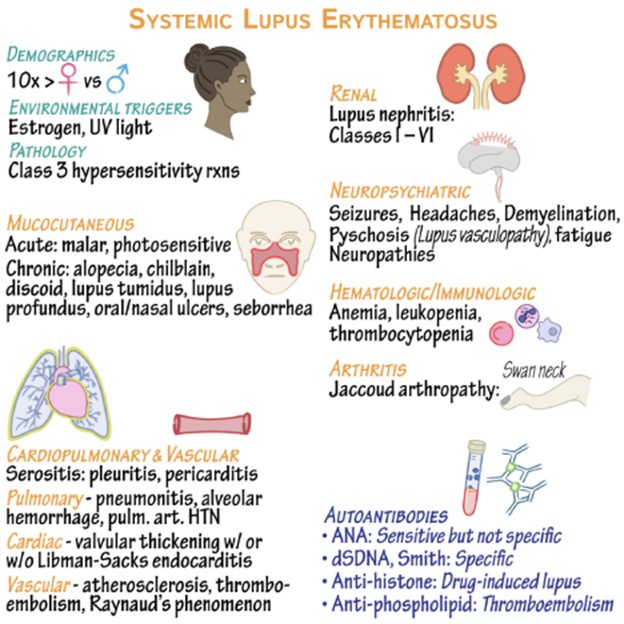The nurse caring for a client with systemic lupus erythematosus (SLE) would include which information in teaching about triggers that can result in an exacerbation of the disease?
Use of acetaminophen to manage pain
Onset of menopause
Ultraviolet (UV) light exposure
Family history of SLE
The Correct Answer is C
Excessive exposure to UV light, such as sunlight or tanning beds, is a known trigger for SLE exacerbations. It is important for individuals with SLE to protect their skin from the sun by wearing protective clothing, using sunscreen, and avoiding direct sunlight during peak hours. Having a family history of SLE increases the risk of developing the disease. While it is not a trigger in itself, it is an important piece of information for the client to be aware of, as it may indicate a genetic predisposition to the condition.
Acetaminophen is a commonly used over-the-counter pain reliever. While it can help manage pain associated with SLE, it is not typically considered a trigger for exacerbations. Menopause, which marks the end of a woman's reproductive years, does not directly trigger SLE exacerbations. However, hormonal changes during menopause can potentially affect disease activity in some individuals. It is important for the client to discuss any changes or concerns with their healthcare provider to manage their symptoms effectively.

Nursing Test Bank
Naxlex Comprehensive Predictor Exams
Related Questions
Correct Answer is C
Explanation
0.9% Sodium chloride is a balanced isotonic solution that closely resembles the electrolyte composition of the extracellular fluid. It is commonly used to treat dehydration because it helps restore fluid volume and electrolyte balance in the body.
5% dextrose in Lactated Ringers: This solution is typically used for fluid and electrolyte replacement in patients who have significant fluid losses or imbalances, but it may not be the best choice for dehydration alone.
0.45% sodium chloride: This solution, also known as half-normal saline, has a lower concentration of sodium chloride and is often used for patients who require hypotonic fluids. It may not provide enough electrolyte replacement for a dehydrated patient. 3% Normal Saline: This solution has a higher concentration of sodium chloride and is typically used for specific indications, such as severe hyponatremia or in critical care settings. It is not the first-line choice for treating dehydration.
Correct Answer is ["B","C","D","E","F"]
Explanation
The normal physiological changes of aging that the nurse can expect in an older adult during a musculoskeletal assessment include:
● Widened Gait: With age, there can be a natural widening of the gait due to changes in balance and stability.
● Kyphosis: Kyphosis refers to an increased curvature of the thoracic spine, commonly known as a "hunchback" appearance, which can occur due to changes in the vertebral bones and intervertebral discs.
● Slowed movement: Older adults may experience a natural decline in their movement speed due to changes in muscle strength, coordination, and reaction time. ● Muscle atrophy: Age-related muscle atrophy, or loss of muscle mass, can occur, particularly if the older adult leads a sedentary lifestyle or has other underlying health conditions.
● Decreased joint ROM (Range of Motion): Older adults may experience a gradual decrease in joint flexibility and range of motion due to changes in the joints, ligaments, and surrounding tissues. This can affect their ability to move joints fully.
It's important to note that while some older adults may develop arthritis, it is not considered a normal physiological change of aging. Arthritis refers to the inflammation and degeneration of joints, which can occur due to various factors, including age, genetics, and lifestyle.
Whether you are a student looking to ace your exams or a practicing nurse seeking to enhance your expertise , our nursing education contents will empower you with the confidence and competence to make a difference in the lives of patients and become a respected leader in the healthcare field.
Visit Naxlex, invest in your future and unlock endless possibilities with our unparalleled nursing education contents today
Report Wrong Answer on the Current Question
Do you disagree with the answer? If yes, what is your expected answer? Explain.
Kindly be descriptive with the issue you are facing.
